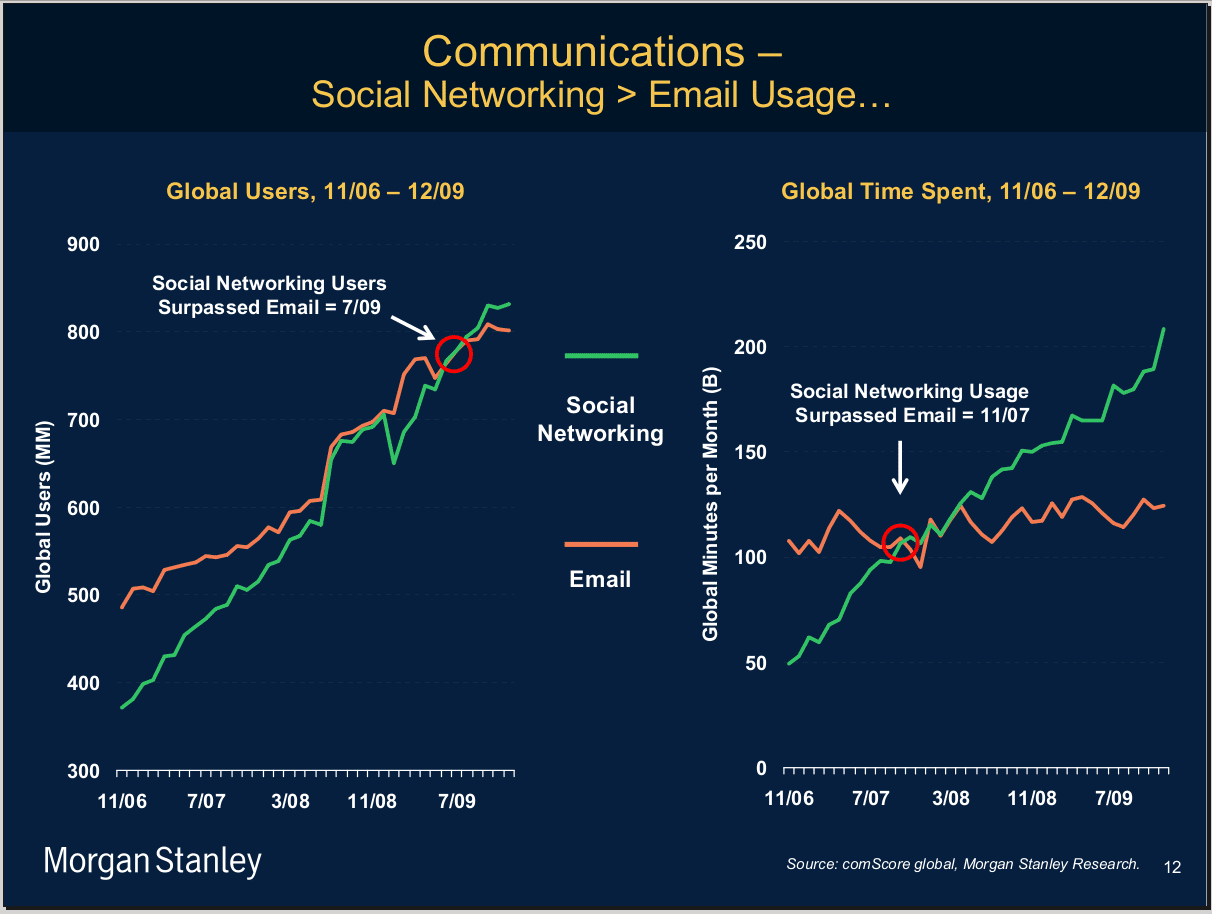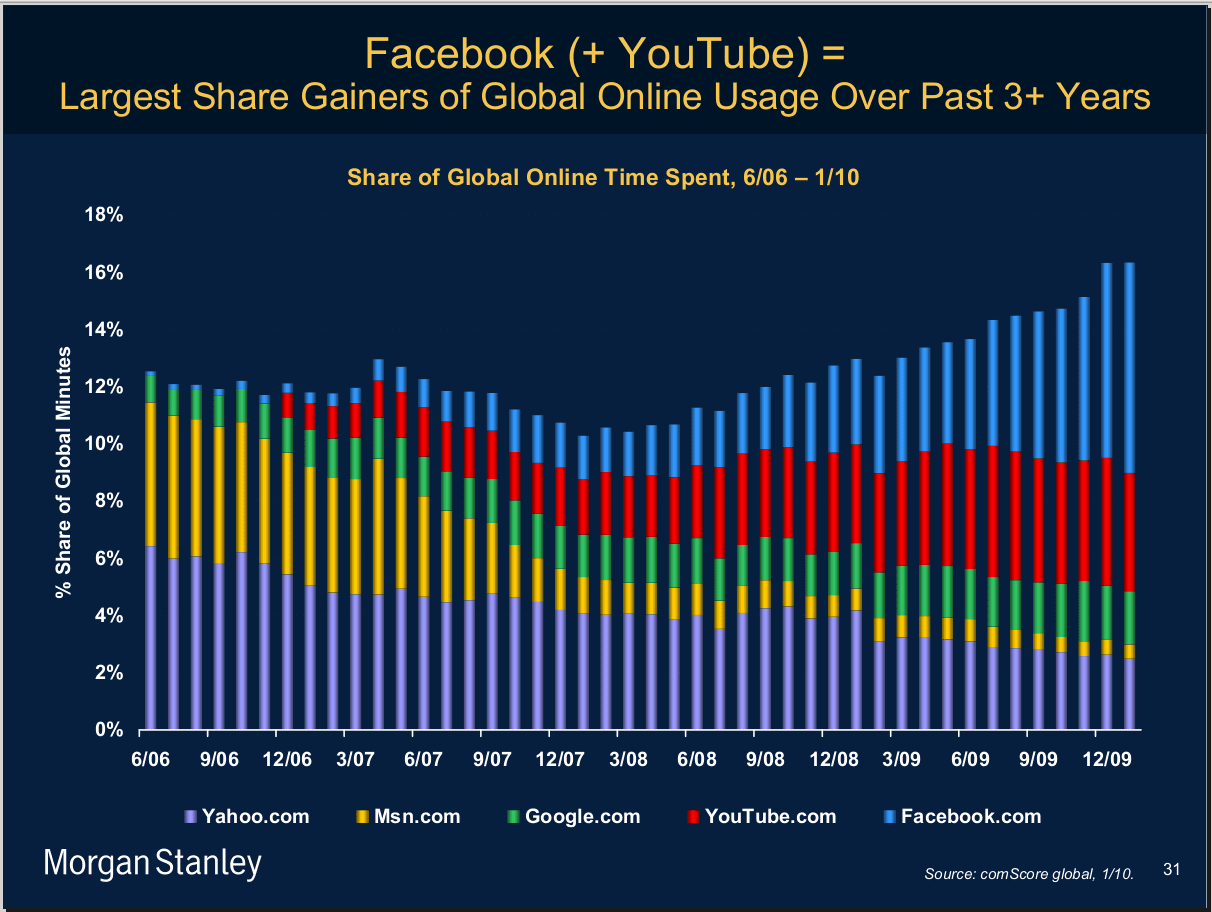via Fred Wilson – a stunning slide from Morgan Stanley’s recent Internet Trends report:

The primary topic of the report is the growth and future prospects of the mobile internet – reason enough read through all 87 slides. However, I am slightly amazed by the fact that eMail runs second to the relatively new phenomenon of Social Networking, driven primarily by consumer behavior and Generation Y.
Admit it – more than once, YouTube and Twitter have made the water-cooler talk circuit, as folks text their kids and rave about connecting with long-lost high school and college chums on Facebook. We’ve all seen upticks in LinkedIn traffic as the economy has driven job networking skills to this professional social network.
The Internet’s “Gen-X” Surpassed
Another Morgan Stanley slide shows how the young-uns have surpassed their web-based brethren – first YouTube, now Facebook have taken over the internet …

In just three short years, a significant movement of mindshare from one web property to another – but don’t stop there. The immersive user experience of Facebook and YouTube is very different from personalized Yahoo and Google portals, and business and social messaging has …
via Fred Wilson – a stunning slide from Morgan Stanley’s recent Internet Trends report:

The primary topic of the report is the growth and future prospects of the mobile internet – reason enough read through all 87 slides. However, I am slightly amazed by the fact that eMail runs second to the relatively new phenomenon of Social Networking, driven primarily by consumer behavior and Generation Y.
Admit it – more than once, YouTube and Twitter have made the water-cooler talk circuit, as folks text their kids and rave about connecting with long-lost high school and college chums on Facebook. We’ve all seen upticks in LinkedIn traffic as the economy has driven job networking skills to this professional social network.
The Internet’s “Gen-X” Surpassed
Another Morgan Stanley slide shows how the young-uns have surpassed their web-based brethren – first YouTube, now Facebook have taken over the internet …

In just three short years, a significant movement of mindshare from one web property to another – but don’t stop there. The immersive user experience of Facebook and YouTube is very different from personalized Yahoo and Google portals, and business and social messaging has changed rapidly to adapt.
So how does that translate to business productivity and process management environment?
Business Process Automation Architecture is Falling Farther Behind
eMail is still the dominate business process environment in corporate America. Don’t believe me? Got users clamoring to switch from Notes to Outlook, or desktop-based to cloud-based service? Try introducing mailbox size limitations or document retention limits, and see how many folks squawk. Spin up a few SharePoint sites and insist that all file sharing be done in shared folders (no attachments allowed!). Insist that all discussions take place in forums, not via Re: and Fw: eMail chains. How successful do you think that will be?
Now, there’s no reason to panic; the population within many corporations have an interesting ability to want consumer level flexibility, speed, usability, and “fun factor” in their personal electronics, but few have that same sense of humor about their day-to-day job. “Go ahead and upgrade, as long as my process does not change at all”.
I’m sure this varies at different corporations – based on the average age of the user population. This is not meant as a slight, just an admission of reality – even I don’t quite get some of the communication norms embraced by my daughters.
However, I am very aware that with each passing quarter, new employees and incoming contractors join our work teams, expecting increasing levels of openness, information access, and social connections. It’s only a matter of time until the internal preference measures match the switch shown in the first slide above – will our business process teams be ready?






